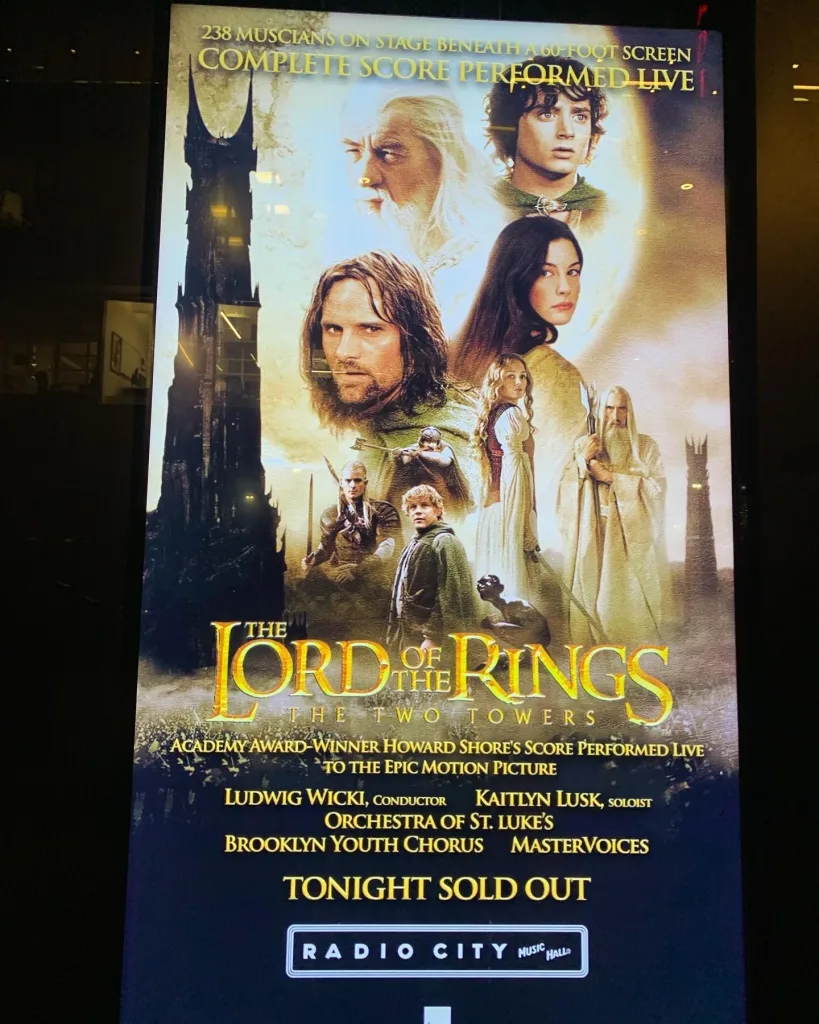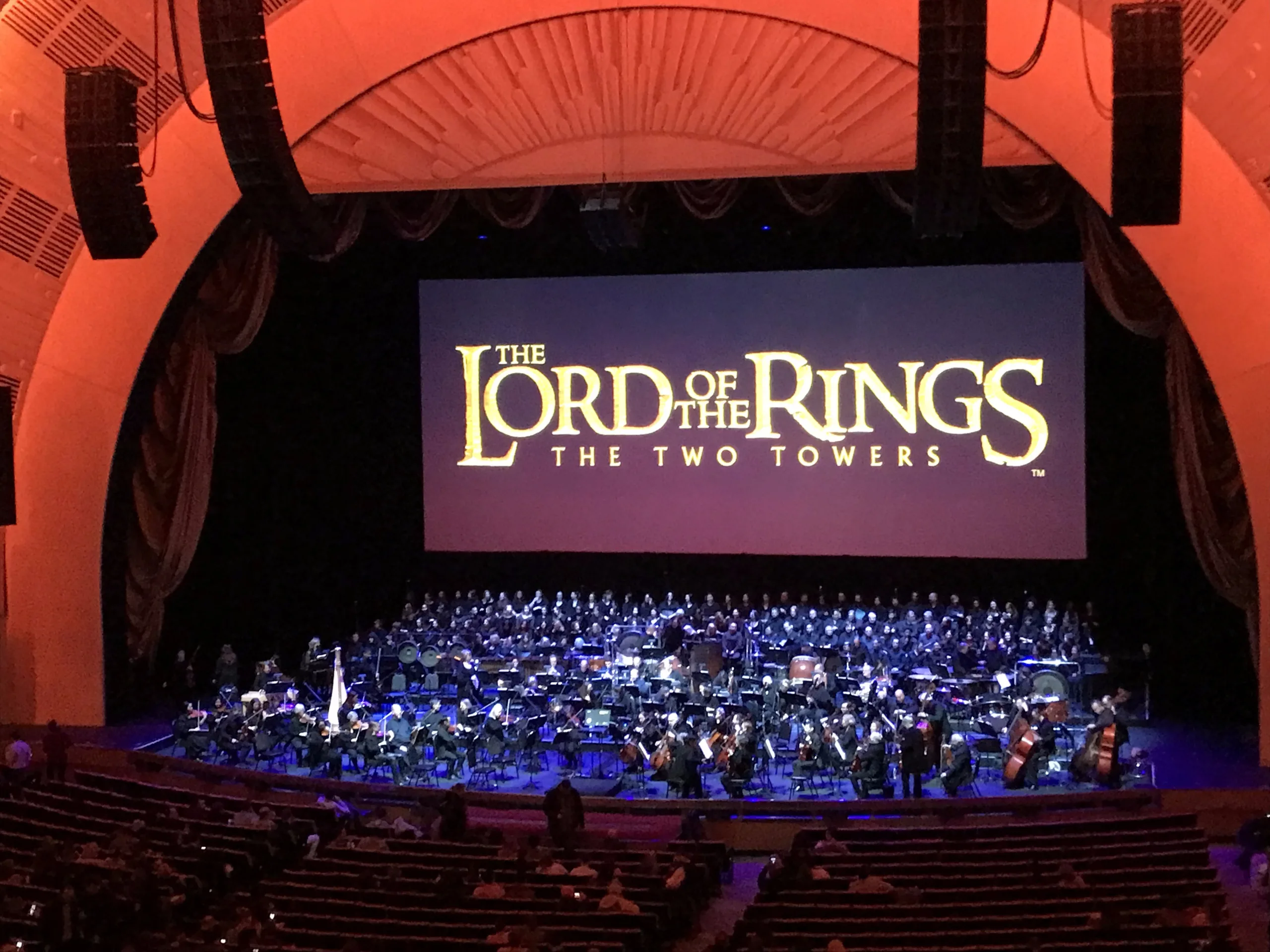Recently, I got to perform the score of The Lord of the Rings: The Two Towers on stage at Radio City Music Hall, where they played the movie and had live instrumentalists and singers perform the music. I was one of 100 adult choristers as part of MasterVoices (altos rule!); there was also a children’s choir (Brooklyn Youth Choir), a full symphonic orchestra (the Orchestra of St. Luke’s), and a mezzo-soprano soloist (Kaitlyn Lusk), all under the baton of Maestro Ludwig Wicki, who worked with Howard Shore to adapt the music for a live show. According to the show’s posters, that was 238 musicians total, and according to how crowded that stage was, that is absolutely accurate (seriously, my score kept whacking into those of my fellow altos).
Don’t let that photo fool ya; the show sold out (the pic was taken by an early birdie who got there before most of the audience). It was quite something, to hear 6,000 movie fans cheering their favorite moments and lines and meme moments.

1. The show is performed around the world, and singers all use the same scores.
They’re issued to us before rehearsals, and we have to return them when we’re done. Which means pretty much all the scores have notes, cues, and markings written in by previous choristers, in an assortment of languages. The Maestro and the soloist travel with the show, but the orchestra and choirs are local.
2. Lyrics? What lyrics?
According to Maestro Wicki, the music comes before the text, which is used more as a vocalise than actual lyrics. Apparently, Tolkien scholars have written to Shore pointing out mistakes in the text, which Shore heartily ignored. Text is presented in the score as a series of syllables. For instance, here’s The Last March of the Ents.
What the text Sindarin says:
rithannen i geven
thangen i harn
na fennas i daur
ol dûr ristannen
What we see:
REE THAN NEN EE EH VEN / THANG GEN EE HAHRN / NAH FEN NAH EE DOWR / OLL DOOR REE THAHN NEN
By the way, that’s not the end of the musical phrase. The end of the phrase comes in the middle of a word, and the boy soprano soloist begins his run on the second syllable of said word.
3. There are more choir parts in the stage show than in the movie
At least the version that’s on Amazon Prime. I watched The Two Towers with my score, mostly out of nerdy curiosity but also because I wanted to see which scenes our singing lined up with. There were multiple parts where my score showed choir entrances, but I didn’t hear any singing in the film. My guess is that some choir parts were taken out during the sound mixing (or sound editing?? what’s the difference??) process to avoid clashing with dialogue. Also, in the Dead Marshes scene, the choir provides a sound effect by whispering text…
4. The tempo changes A LOT
To keep up with the push and pull of dramatic moments in the movie, the pacing of the music is constantly shifting. There are some parts where we have a different tempo in every measure… things might be getting increasingly faster to build up to a big moment, or slow abruptly for dramatic effect (such as when Gandalf the White appears). The time signatures are also super fluid—one measure might be in 3, followed by one in 5—which allows the music to stretch out or contract. The only way to keep us to watch the maestro LIKE A HAWK.
Speaking of Maestro, because he needs such precise pacing for the movie (which, after all, will not stop and wait if we fall behind, or speed up if we get ahead), he’ll often mouth the syllables of the choir parts to show us exactly what timing he wants. As long as we mirror him, we’re good!
There are also a few parts with no music, and he’ll sometimes mouth along to the movie’s dialogue just for fun (my favorite is him doing “PO-TA-TOES!”)
6. We breathe at random times
The Lord of the Rings music includes a lot of suuuuuuper long phrases, and no individual human could sing for so many measures without breathing. Fortunately, there are a hundred of us in the choir. To give the illusion of unbroken lines of music, we all sneak breaths at random moments. Just don’t breathe at the same time as your neighbors…
7. The choir can barely hear the movie
The sound design at the theater is for the audience to get the best audio experience, and the speakers are actually in front of the stage. Which means from the back, where the choir is, we can barely hear the movie, and what we do get is weird and reverb-y. Especially since we’re right behind the percussionists, and they are LOUD, there are several parts we can’t hear at all. We also can’t see the movie, which is behind us, which means we really have to rely on music cues to know when to come in.
8. Dress rehearsal and the first performance are on the same day
From 1ish in the afternoon to 5ish in the afternoon, we did our dress rehearsal, which was the first and only time we got to run through the whole movie without an audience. At 8PM that same evening, we did our first show. The reason for that is so the show only has to rent the hall on the days we’re performing; otherwise the hall would be dark the night before (and be making zero moneys).
9. The dressing rooms aren’t on stage level
For the choir, they’re on the third floor stage left, which means to get out after the show, some of us have to get off, cross behind the whole stage, then go up three flights (or wait for the elevator… of which there is exactly one). So it can take a while to leave after the show!
10. The choristers don’t get paid
The choirs get paid, as in the organizations, but the individual singers (for both the adult and youth choruses) are there on a volunteer basis, because we love the music, and the opportunity to perform, and, in many cases, The Lord of the Rings.

